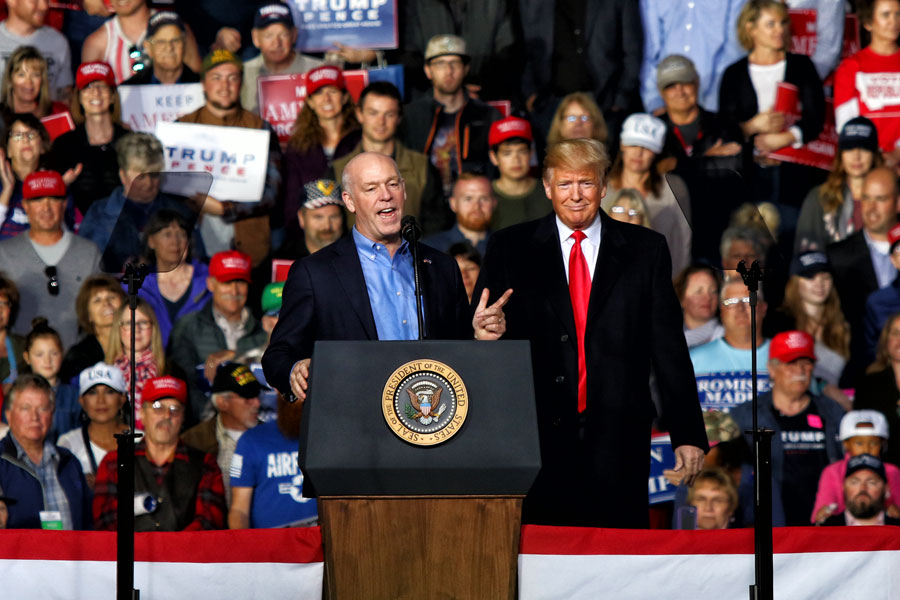Republican Gianforte Bests Williams in Race for Montana’s Sole U.S. House Seat
Incumbent Congressman heads back to Washington for his first full term, pledging to represent state’s best interests
By Tristan Scott
Greg Gianforte (R) — (51%) 251,611
Kathleen Williams (D) — (46%) 227,036
Elinor Swanson (L) — (3%) 13,951
Why it Matters
Montana’s lone seat in the U.S. House of Representatives has been occupied by a Republican for more than two decades, and Greg Gianforte’s victory sends him to his first full term representing Montana’s at-large congressional district, solidifying his reputation as a serious legislator.
Although Democrat Kathleen Williams lost by a sizable margin, support for the former state representative is the most a Democrat has received in the race since Nancy Keenan lost to Denny Rehberg in 2000.
Despite Democrat Jon Tester’s decisive victory in the race for U.S. Senate, Gianforte won the House race by nearly 25,000 votes, which is testament to Montanans historic and logic-defying patterns of splitting the ticket.
By handily winning the race for Montana’s lone seat in the U.S. House of Representative, Republican Greg Gianforte heads back to Washington for his first full two-year term on the heels of a shortened stint in Congress due to a 2017 special election.
The wealthy tech entrepreneur’s reelection is significant for a number of reasons, not the least of which dates back to the eve of his special-election victory, when he assaulted a reporter in a now-infamous incident reported nationally, and which President Donald Trump remarked on recently at a rally for Republican support in Missoula.
The special election for Montana’s at-large congressional district was held May 25, 2017, and was necessitated because of Republican Ryan Zinke’s appointment as U.S. Secretary of the Interior, a cabinet position that forced him to resign upon confirmation.
Despite the large-looming allegations that he body slammed Guardian reporter Ben Jacobs — a charge to which Gianforte later pleaded guilty — the Bozeman resident cruised to victory, and the power of his incumbency was on full display during the Nov. 6 general election, which saw near-record voter turnout in Montana, which is rare in times of an off-year midterm election.
In the weeks leading up to the general election, the congressman also gained strong support from President Donald Trump and his surrogates, frequently appearing on stage at rallies during an unprecedented four presidential visits to the Treasure State in an effort to mount support for the Republican ticket, both for Matt Rosendale in the hunt to unseat U.S. Sen. Jon Tester, as well as Gianforte’s bid for the House.
And while Trump’s rally cries failed to provide the momentum in Rosendale’s race, it may have figured into Gianforte’s reelection, which saw him gain 5,000 more total votes than Tester at a time when he was potentially still vulnerable.
Historically, an incumbent candidate is most prone to be unseated during his or her first time running for reelection, and while it was widely predicted that Gianforte would prevail, polling forecasts predicted a tight race, and his substantial victory emboldened the congressman.
“The people of Montana have spoken. With a full heart, I thank voters throughout our great state who have given us this victory,” he said. “I am grateful for your trust and for the opportunity to serve you.”
For her part, Williams ran her campaign on principles that resonate with Montanans, including her desire to moderate the current climate of hyper-divisiveness in Washington politics and restore civility; her conservation ethics; her expertise working on technical issues like water rights; the importance of preserving coverage for people with preexisting conditions; and her record as a moderate state legislator.
In attempting to distance herself from national Democrats, she ran ads about her support for the Second Amendment and gun rights.
But the Gianforte campaign’s game plan included tying Williams to House Minority Leader Nancy Pelosi, D-California, who is reviled in Republican circles, despite Williams saying she wouldn’t support Pelosi as speaker if the Democrats regained control of the House, which they did. Gianforte also portrayed the Democrat as opposed to gun rights.
According Neal Ullman, who worked as communications director on Williams’ campaign, the Democrat hopes the support Montanans showed her — she tallied more votes than any Democrat for the state’s lone House seat has in nearly two decades — resonates with Gianforte, who has been criticized for not meeting directly with voters to discuss contentious issues.
“We hope that the congressman heard the message that Montanans want their voices to be heard, even on issues that might be disagreeable,” Ullman said.
To that end, Gianforte promised to represent all of his constituents as fairly as possible, despite their political stripe.
“While Kathleen and I might disagree on the issues, we both share a passion for serving the people of Montana,” according to a statement. “[On Nov. 6], Montanans made a decision, and I appreciate your continued confidence. I renew my commitment to serve all Montanans, whether I earned your vote or not. I’ll continue putting Montana first and working with President Trump to keep our economy thriving, make our communities safer, keep our public lands in public hands, and protect our Montana way of life.”